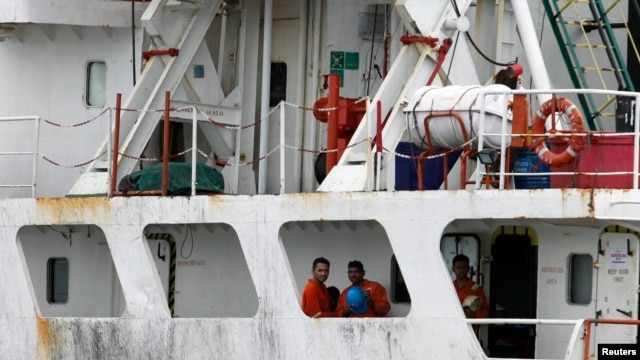
Tuesday, June 18, 2013
by Selah Hennessy

Crew members of the Panama-flagged cargo ship MV Asphalt Venture look out from the ship at the Kenyan Port of Mombasa, April 28, 2011.
According to the International Maritime Bureau’s data, the total number of seafarers attacked by pirates decreased significantly in 2012.
But it says although the number of attacks decreased, there was a sharp rise in their reported success rate. That, it says, could be an indication that piracy tactics have improved.
And, according to the report, the level of violence has not gone down either.
Pottengal Mukundan, director of the IMB Piracy Reporting Center, says all hostages held in Somalia are considered "high risk."
“We have had cases of physical torture of the crew members and psychological pressure being put upon them. After they are released from captivity they need a lot of aftercare to make sure they are able to sail again and that is not being done in many of the countries that supply crew members,” said Mukundan.
IMB published the report together with two other groups - Oceans Beyond Piracy and the Maritime Piracy Humanitarian Response Program. The report is based on a number of interviews with seafarers and their families about the physical and psychological impact of piracy.
Mukundan says the IMB and ship owners often struggle to learn about the condition of sailors held by Somali pirates.
“There are still crew members who have been held there for more than two years and there is still very little information coming out about where they are, who is holding them, and under what terms they are going to be released,” said Mukundan.
Seafarers captured off the east coast of Africa are typically held for much longer than those captured on the west coast. But the number of seafarers impacted by West Coast piracy is actually higher.
In 2012, 966 seafarers were attacked by West African pirates. Just over 200 were taken hostage. But, as the report points out, attacks in the Gulf of Guinea regions have not received the same level of attention.
The main risk area is off the coast of Nigeria, the region’s major oil producer. Mukundan says pirates typically target tankers exporting crude oil and importing refined petroleum, later selling the cargo on the black market.
“They don't steal all the cargo; they steal a part of it - three or four thousand tons. Once they have stolen the cargo, then the vessel and the crew are normally released," said Mukundan.
And in the Gulf of Guinea region, ships do not have the protection offered by international navies that patrol the waters off Somalia.
As a result, seafarers are growing increasingly wary of working in the Gulf of Guinea region.